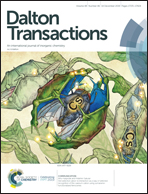Reversible photo-isomerization of cis-[Pd(L-κS,O)2] (HL = N,N-diethyl-N′-1-naphthoylthiourea) to trans-[Pd(L-κS,O)2] and the unprecedented formation of trans-[Pd(L-κS,N)2] in solution†
Abstract
Upon ex situ UV-visible light irradiation, complex cis-bis(N,N-diethyl-N′-naphthoylthioureato)-palladium(II), cis-[Pd(L-κS,O)2], undergoes isomerization in acetonitrile-d3 and chloroform-d to yield trans-[Pd(L-κS,O)2] which then rearranges thermally to novel trans-[Pd(L-κS,N)2] prior to reverting thermally to the cis isomer in the absence of light. The thermal isomerization rate is highly solvent dependent and harnessed to enable each of these three geometric isomers to be isolated and characterized by 1H NMR spectroscopy, X-ray crystallography, melting point and thermal analysis. The formation of the trans-[Pd(L-κS,N)2] isomer as part of this isomerization has only been observed with the sterically demanding cis–bis(N,N-diethyl-N′-(naphthoylthioureato)palladium(II) precursor based on our knowledge to date. In situ irradiation with monochromatic laser light (λ = 355 nm) coupled to 1H NMR spectroscopy of solutions of cis-[Pd(L-κS,O)2] in acetonitrile-d3 supports the ex situ photo-induced isomerization experiments.
![Graphical abstract: Reversible photo-isomerization of cis-[Pd(L-κS,O)2] (HL = N,N-diethyl-N′-1-naphthoylthiourea) to trans-[Pd(L-κS,O)2] and the unprecedented formation of trans-[Pd(L-κS,N)2] in solution](/en/Image/Get?imageInfo.ImageType=GA&imageInfo.ImageIdentifier.ManuscriptID=C9DT03672E&imageInfo.ImageIdentifier.Year=2019)
- This article is part of the themed collection: Breaking bonds over many timescales: in celebration of Robin Perutz’s 70th birthday


 Please wait while we load your content...
Please wait while we load your content...